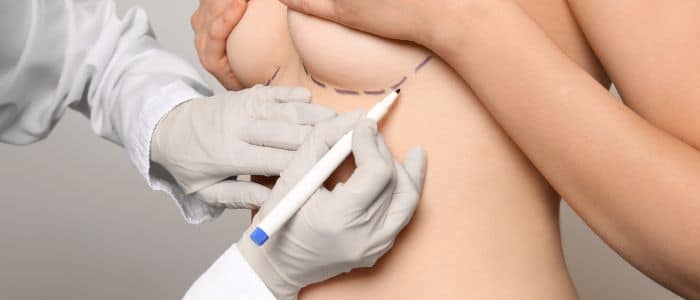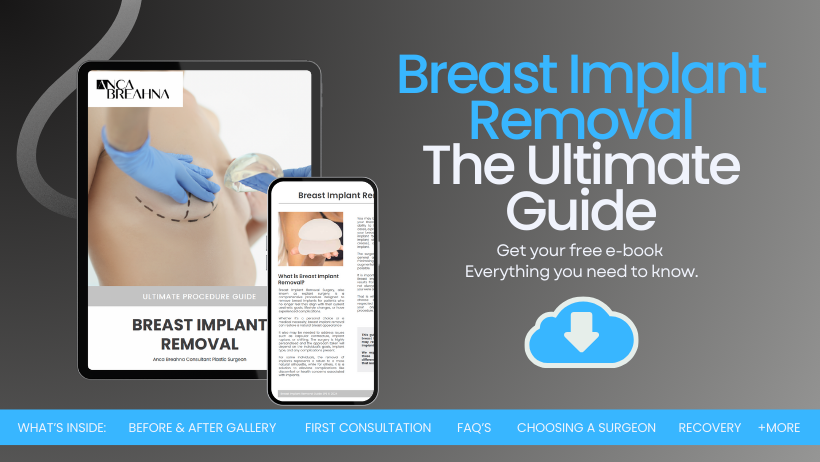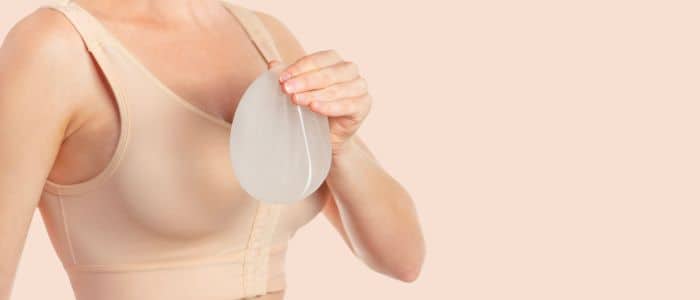
Reducing Breast Implant Removal Scars
Breast implant removal surgery, a procedure that many women undergo, is an intricate process that requires both medical expertise and personal preparation. You might have chosen to have your breast implants removed for a variety of reasons, including health concerns, changes in aesthetics, or complications arising from previous surgeries. However, like with any surgical procedure, the aftermath often brings about scarring which can cause distress and anxiety.
In this blog, Chester Consultant Plastic Surgeon Anca Breahna aims to provide you with an understanding of breast implant removal scars and techniques to minimise their appearance. It is important to remember that each person’s experience is unique, and your journey might differ based on various factors.
Download Anca Breahna’s Breast Implant Removal Guide

What Are Breast Implant Removal Scars?
Breast implant removal scars are the visible marks left on the skin following the surgical removal of breast implants. These scars can range in size, shape, and colour, and their visibility largely depends on the surgical technique used, your body’s natural healing ability, and the aftercare provided.
While they may initially be red and somewhat raised, over time, these scars tend to fade and flatten. However, in some cases, they may remain visible and cause discomfort or insecurity. It’s important to understand that scarring is a natural part of the healing process following surgery, and while it can’t be completely avoided, there are ways to minimise its appearance.
What Happens During Breast Implant Removal Surgery
Breast implant removal surgery is a surgical procedure that involves the removal of previously placed breast implants. Depending on your specific circumstances, the surgery may also involve the removal of any scar tissue that has formed around the implants, a procedure known as a capsulectomy.
The surgery typically lasts between one to three hours and is performed under general anaesthesia. An incision is made, usually along the same lines where your initial breast augmentation surgery was performed to minimise additional scarring. The implants are then carefully removed, and any necessary additional procedures are performed.
Postoperatively, you will have dressings applied to the incision sites, and a support bra may be recommended to help minimise swelling and support your breasts as they heal. Recovery time varies from person to person, but typically, you can expect to return to your normal activities within two to six weeks.
Factors Affecting the Severity of Breast Implant Removal Scars
The severity of breast implant removal scars can be influenced by several factors. These include your skin type, the surgical technique used, the surgeon’s expertise, your body’s healing capabilities, and the aftercare provided.
Your genetic make-up plays a significant role in how your skin heals and scars. Some people naturally produce more collagen during the healing process, which can lead to raised, thicker scars. On the other hand, some individuals may heal with minimal scarring.
The surgical technique and the surgeon’s skill level can also significantly impact the appearance of scars. A skilled surgeon will aim to minimise scarring by making precise, clean incisions and suturing them meticulously. However, even with the best surgical techniques, some degree of scarring is inevitable.
Techniques to Reduce Breast Implant Removal Scars
While it’s not possible to completely eliminate breast implant removal scars, various techniques can help reduce their appearance. One of the most effective ways is through scar massage. This involves applying pressure to the scar and moving the skin in a circular motion. This helps to break down the scar tissue and promote blood flow, which can aid in healing and reduce the scar’s visibility.
Silicone sheets or gels can also be beneficial. They work by flattening and softening the scar, reducing its size and improving its colour. They are applied once the wound has fully healed, and it’s recommended to use them consistently for several months for the best results.
Protecting your scars from the sun is crucial. Sun exposure can darken scars and make them more noticeable. Always apply a high SPF sunscreen to your scars, and try to keep them covered when in direct sunlight.
Treatments for Minimising Breast Implant Removal Scars
If your scars are significantly affecting your quality of life, there are medical treatments available that can help minimise their appearance. These include laser therapy, steroid injections, and surgical revision.
- Laser Therapy: This advanced treatment involves the use of concentrated light beams to target and break down scar tissue. The process not only helps in diminishing the appearance of the scar but also promotes the regeneration of healthy skin cells. By doing so, laser therapy can effectively improve the texture and colour of the scarred area, making it blend more seamlessly with the surrounding skin. This non-invasive procedure is often preferred for its precision and the reduced recovery time compared to more invasive methods
- Steroid Injections: Steroids are known for their anti-inflammatory properties, and when injected directly into the scar tissue, they can play a significant role in scar management. These injections work by reducing inflammation and slowing the production of collagen in the scar area. Excess collagen can lead to raised, more noticeable scars. By controlling collagen production, steroid injections can prevent the scar from becoming hypertrophic or keloid, which are typically more prominent and harder to treat
- Surgical Revision: In cases where non-invasive treatments are not sufficient, surgical revision might be considered. This procedure involves the careful removal of the existing scar tissue followed by a meticulous re-closure of the wound. The goal of surgical revision is to create a new, finer, and less noticeable scar. This method can be particularly effective for scars that are raised, puckered, or otherwise irregularly healed. The success of surgical revision often depends on the skill of the surgeon and the body’s healing response
These treatments should be discussed with your plastic surgeon to understand the potential benefits and risks associated with each.
Natural Ways to Minimise Breast Implant Removal Scars
Alongside medical treatments, there are natural ways to help minimise breast implant removal scars. These include the use of natural oils and creams, a healthy diet, and regular exercise.
Natural oils, such as vitamin E, rosehip, and coconut oil, have been shown to promote skin healing and reduce the appearance of scars. It’s important to only start using these oils once your wounds have fully healed to avoid any potential complications.
A healthy diet rich in vitamins and minerals can support your body’s natural healing process. In particular, foods rich in vitamin C, zinc, and protein can aid in wound healing and scar reduction.
Regular exercise can also help by improving your blood circulation, which can aid in delivering essential nutrients to your skin and promoting healing.
Importance of Aftercare in Reducing Breast Implant Removal Scars
Aftercare is crucial in reducing the appearance of breast implant removal scars. This includes following Anca’s post-operative instructions, keeping the incision site clean and dry, and avoiding any strenuous activities until you’re fully healed. Anca may recommend specific products or exercises to help reduce scarring. It’s important to follow these recommendations consistently and patiently, as healing and scar reduction take time.
While breast implant removal scars are a natural result of the surgery, there are ways to minimise their appearance. By understanding the process, following aftercare instructions, and exploring both medical and natural scar reduction techniques, you can take control of your healing process.
FAQs about How to Minimise Breast Implant Removal Scars
How bad are the scars after breast implant removal surgery?
- The severity of scars following breast implant removal surgery can vary depending on several factors, including the individual’s skin type, the surgical technique used, and the body’s natural healing process. Anca aims to minimise scarring by using previous incision sites for implant removal. However, some visible scarring is inevitable. These scars are usually small and may fade over time, but their final appearance can differ from person to person.
Do breast implant removal surgery scars ever disappear completely?
- It is unlikely for scars from breast implant removal surgery to disappear completely. Over time, scars usually become less noticeable as they fade and mature, potentially becoming thin, flat, and closer to your skin tone. The extent of this change varies among individuals. Factors like genetics, skin colour, and post-operative care play a significant role in the healing process. While scars improve in appearance, they do not vanish entirely.
Where are the scars localised when breast implant removal is performed?
- The localisation of scars from breast implant removal surgery depends on the surgical technique used and the location of the original incisions. Commonly, Anca uses the same incision sites made for the breast implant insertion. These incisions are often located under the breast along the crease (inframammary fold) or around the areola (periareolar). This approach helps in limiting additional scarring.
What can I do before the surgery to make sure I have less visible scars after breast implant removal?
- To ensure less visible scarring after breast implant removal, it’s important to follow a healthy lifestyle and proper skin care regimen before the surgery. This includes maintaining a balanced diet rich in vitamins and minerals that promote healing, staying hydrated, avoiding smoking, and managing any existing health conditions. Consulting Anca about pre-operative skin treatments or supplements that might improve skin elasticity and healing can also be beneficial. Additionally, ensuring your skin is in good condition before surgery can aid in better healing post-operatively.
Is massage indicated to reduce breast implant removal scars?
- Massage can be an effective method to reduce scarring after breast implant removal surgery, but it should only be done following Anca’s approval and instructions. Gentle massage to the scar area can help in breaking down the scar tissue, improving circulation, and promoting healing, which may lead to softer and less visible scars. However, it’s crucial to wait until the incision has fully healed and to follow a technique recommended by your surgeon to avoid any complications.
Further Reading about Breast Surgery with Chester Consultant Plastic Surgeon Anca Breahna
- Read more about Recovery after Breast Implant Removal Surgery
- Read more about Types of Breast Implants
- Read more about Breast Implant Removal And Replacement (Capsulectomy)
- Read more about Breast Implant Removal And Uplift
- Read more about Fat Transfer To Breasts / Lipofilling
- Read more about Top 10 Benefits of Wearing a Compression Garment after Breast Implant Surgery
- Read more about When Can I Exercise after Breast Implant Removal Surgery?
- Read more about Treating, Reducing and Minimising Plastic Surgery Scars
Medical References about Breast Implant Removal Surgery and Scars
- Breast Implant Removal: What to Expect, Surgery & Recovery – Cleveland Clinic
- Breast Implant Removal Procedure Steps – American Society of Plastic Surgeons
- Breast Implant Removal (Explant Surgery): What To Expect
- What Can We Learn from Breast Implant Explantation
- Exploring Factors Associated with Implant Removal Satisfaction in Breast Implant Illness Patients



 Ms Anca Breahna, PhD, MSc, FEBOPRAS, FRCS (Plast) is a highly regarded Consultant Plastic Surgeon specialising in the field of Aesthetic and Reconstructive Plastic Surgery. Anca performs a range of
Ms Anca Breahna, PhD, MSc, FEBOPRAS, FRCS (Plast) is a highly regarded Consultant Plastic Surgeon specialising in the field of Aesthetic and Reconstructive Plastic Surgery. Anca performs a range of 